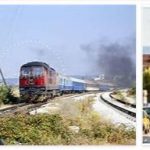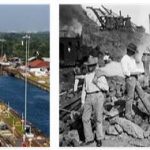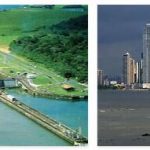One of the most powerful factors of the great economic development of Belgium, one of the most valid elements of the social arrangement of the whole country, is in the communications system with which it was modernly equipped. First on the European continent to plant the railway on its own soil, Belgium owned at the end of 1926, km. 5102 of railways (state-owned 4781), to which 496 km are to be added. of local railways, economic lines that is, narrow-gauge, generally following the rolling roads and putting even the most remote countryside in contact with the general circulation of the country. With such a development, Belgium is, not for a few years, at the head of all the states in the world in terms of network density: 31 km. of railway for every 100 sq. km. of territory, while Great Britain has only 13, France 10, the Italy 7. When we add the other factor of the extreme modality of tariffs, we understand how such an abundant network, in addition to facilitating agricultural and industrial development in an extraordinary way with the rapid and economical transport of foodstuffs, has served immensely to decentralize industries avoiding their crowding in a few congested urban centers, and saved the countryside from depopulation for the benefit of the cities: the residents of the countryside have in fact become workers of large industries without abandoning the rural life and the family farm, the large agglomerations urban areas have grown in activities and works without thereby reaching the plethoric proportions of the “sprawling cities” of other countries. Naturally, the movement of citizens rises to significant figures:
Waterways are of little less importance, at least as regards the movement of goods, including, in addition to the river network for a large part navigable, a vast network of canals already begun in past centuries according to what suggested the flatness of the territory. Channels connecting the great Flemish centers already existed in the century. XIII: today the benefit has also extended to the lower part of the country, despite the difficulty of the differences in height that some canals (Charleroi-Mons, Charleroi-Brussels) have to overcome by means of conspicuous artificial works. In total, the network, certainly not lacking in imperfections, embraces 1674 km between rivers and canals, including 114 km. of canals that can be used by sea vessels, which from Antwerp can go up to Louvain and Brussels, from Zeebrugge to Bruges, from Ostend to Ghent. For every 100 sq. km. you have km. 7.5 of waterways, with a proportion higher than that of almost all European states; however, the greatest quantity of goods is always transported by railways, with only 45 per cent of the total being normally entrusted to waterways. Water communications are also excellent with France, thanks to the Scheldt and Meuse routes and the derived channels, less good with Germany, lacking direct communication with the lower Rhine, which it should cross of necessity (when the neighboring state allows it) the Dutch territory. For Belgium travel information, please check zipcodesexplorer.com.
Just as nature has granted Belgium easy communications by land and inland waters, so it has benefited him by opening the seaways in the most favorable way. In truth the 66 km. of the coast are only a dangerous straight line of sands, with very shallow waters, where, erased from the events of the times the ancient inlets, only very expensive artificial works of piers and castings have created and maintain landings in Ostend and Zeebrugge (Ostend, head of line for rapid passenger transport to England: 307,000 passengers in 1926). But this unhappiness of the coast is largely compensated by the presence of the magnificent Schelde estuary, which, although it opens its mouth in Dutch territory, however, is in Belgian territory, 88 km away. from the sea, its internal vertex, ships entered 12.718 with a tonnage of tons. 23,750,000, with an enormous prevalence of the movement of goods over that of travelers). There are 190 shipping lines landing here: only 6 per cent of the Belgian flag, however, keeping the Belgians singularly alien to maritime activities. One third of Antwerp imports and two thirds of exports are transit trade. Ghent, which follows as a movement to Antwerp, barely reaches one sixth of it in terms of the number of ships arriving. One third of Antwerp imports and two thirds of exports are transit trade. Ghent, which follows as a movement to Antwerp, barely reaches one sixth of it in terms of the number of ships arriving. One third of Antwerp imports and two thirds of exports are transit trade. Ghent, which follows as a movement to Antwerp, barely reaches one sixth of it in terms of the number of ships arriving.
Belgium has a merchant fleet of 200 units (of which 150 steam units) with a cargo of 492,000 tons; there are 37 Belgian shipping companies. In addition, 20 steamers and 12 on the lower course operate on the upper course of the Congo.
Civil aviation. – Civil aviation temporarily depends on the Ministry of Transport and Communications and takes care of everything related to air traffic.
Air navigation company. – The only company that has a monopoly on air transport in the country and in the colony is SABENA (anonymous company for the exercise of air navigation). Founded in 1922, after the bankruptcy of the previous company, it reached a capital of 20 million francs. The company is subsidized by the government for 6 million francs a year; has agreements with some foreign companies for the management of airlines to England, Germany and France; has 10 pilots and 18 aircraft, of which 7 Handley-Page three-engined, 2 HP twin-engined, 2 Goliath, 3 DH, 2 Rumplers and 1 Junkers.
The foreign companies that operate airlines across the Belgian territory are: Imperial Airways, Farman and Compagnie Royale des transports aériens.
The airlines operated exclusively by the Belgian company are: the Brussels-Antwerp-Düsseldorf km. 200, 2 hours, daily service; the Brussels-Ostend, km. 120, 1 hours, daily service.
The international airlines operated by foreign companies in cooperation with the Belgian company are: London-Ostend-Brussels-Cologne, managed by Imperial Airways in cooperation with SABENA: daily service, the route of km. 490 is carried out in 4.30 hours; the Paris-Brussels-Antwerp-Rotterdam-Amsterdam, managed by Farman in cooperation with SABENA: daily, km. 470, 4.30 am.
The international lines managed exclusively by foreign companies are: the Paris-Brussels-Amsterdam: daily service, managed by the Farman company, km. 420, 3.30 hours; the Amsterdam-Rotterdam-Brussels-Basel-Zurich: daily service, managed by the company Royale des transports aériens, km. 550, 6 hours.
Air bases. – They are mainly the following:
- Antwerp, civil airport, 4 km. E. from the city; measure m. 1000 by 800; it has a hangar and a repair shop;
- Asch, military airport, 1 km. S. from Asch; measure m. 1100 by 800; it has 5 metal hangars and a small repair shop;
- Bierset-Awans, military airport, 8 km. O. from Liège; measure m. 700 by 600; it has 4 hangars, a warehouse, a workshop;
- Brussels, civil and customs airport, about 5 km. NEITHER. from the city center; measure m. 1000 by 850; it has 5 metal hangars and a workshop;
- Kortrijk, military airport, about 4 km. O.-SO. from Courtrai; measure m. 800 by 400; it has 5 hangars and a small workshop;
- Ostend, customs airport, km. 2,5 S. from the station; Inisura m. 550 by 480; has 2 metal hangars;
- Nivelles, military and customs airport, 2 km. E. from the city; measure m. 850 for 800; has 3 hangars;
- Schaffen, military airport, 2 km. N.-NE. from the city center of Diest; measure m. 650 by 600; has 4 metal hangars;
- Saint-Hubert, civil airport, km. 2.5 E.-NE. from the city; measure m. 810 for 811; it has 3 hangars, a repair shop, a radio-telegraph station;
- Tirlemont, military airport, 3 km. S.-SE. from the city; measure m. 750 by 600; has 7 hangars and a workshop.
- Minor airports are in Beverloo, Brasschaet, Elsenborn (military), Charleroi (private).









